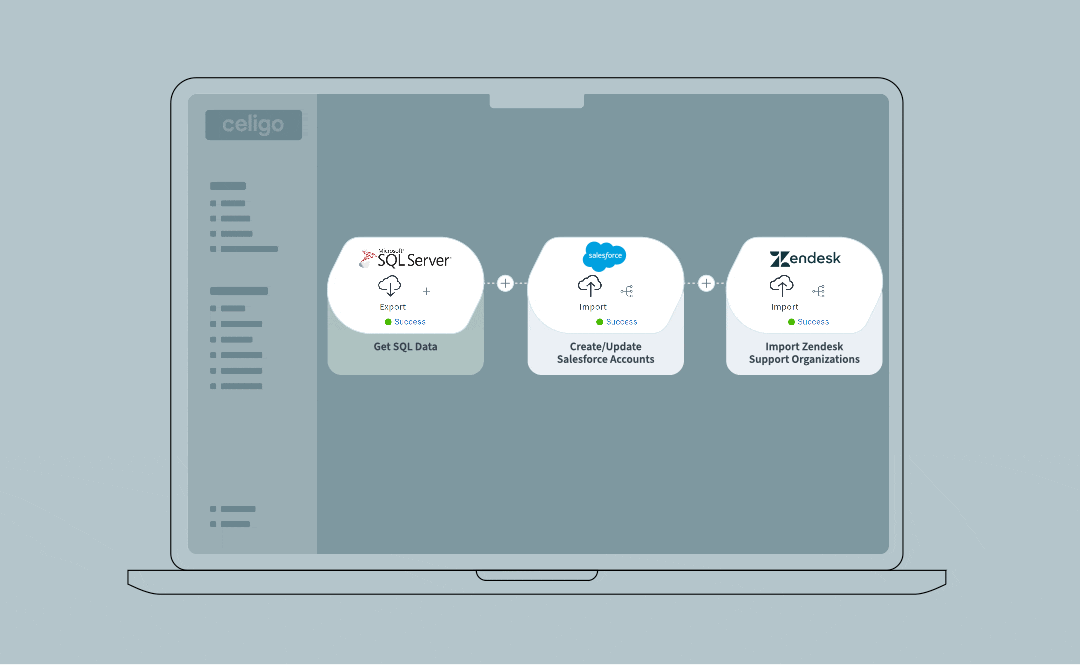Published Dec 16, 2022
What is integration platform as a service (iPaaS)?
The essential guide to integration platform as a service

An Introduction to iPaaS
An iPaaS, or integration Platform as a Service, is a platform that standardizes how applications are integrated into an organization, making it easier to automate business processes and share data across applications.
By leveraging iPaaS technologies, growing companies can eliminate manual processes and reduce dependency on spreadsheets and email, while increasing visibility, speed, and accuracy across their organization.
The Challenge of Integration Today
The variety of business applications available today address every conceivable challenge that a company could encounter. Most of these apps are simple to use, easy to set up, offer beautiful interfaces, and require no training.

Because apps are so easy to deploy, IT teams are no longer responsible for the purchasing and implementing many business apps. Now, individual departments can pick the best-of-breed apps they want to best tackle their specific tasks. This trend is a direct result of the “Consumerization of the Enterprise” and has yielded an explosion in the number of SaaS apps, called SaaS sprawl, which shows no sign of slowing down.
For example, the infographic by Chief Martech below illustrates what the marketing technology app landscape looked like in 2011 compared to 2019:

Too Much of a Good Thing
But as amazing and essential as many of these apps may be, is it possible to have too many of them?
Contributors siloed in different departments may not see how their individual data and processes fit within the workings of the wider organization, and these application generate and need their own data. Yet, many critical business processes — quote-to-cash, 3PL fulfillment, item management, procure-to-pay, and many more — span a variety applications across multiple departments.
As the volume of data grows, so do data silos, leading to manual processes, data entry, management via spreadsheets and email, lack of visibility across the organization, and costly manual errors. The fluid exchange of information is critical in any organization, large or small. As the volume of data and complexity of an organization expands, establishing a robust automation strategy is critical.
A key component of this approach involves connecting disparate applications. This process is known as ‘integration,’ and to achieve it, most companies use a hodgepodge of tactics to combine their many business processes.
How Companies Tackle Integration
The concept of integrating applications has existed for years. But for most companies, it’s an afterthought after new applications are added. From there, integration projects are tackled on an as-needed basis. When they ultimately do move forward, companies often use a patchwork of application integration solutions.
Vendor-Built or Native Integrations
Most software includes out-of-the-box native integrations allowing users to quickly connect with specific applications. For example, practically every marketing automation tool today connects directly to Salesforce. This is very convenient, often covers the most popular use cases, and usually don’t have additional subscription costs.
However, the challenge with native integrations is that they are designed to sell and renew the vendor’s offering and typically only cover the use cases that will check the box in the sales cycle. This means they are typically static, not designed with enough flexibility or customization capabilities to address important edge cases.
Third-Party Point-to-Point (P2P) Connectors
Just like vendor-built integrations, point-to-point connectors may be very convenient and cost-effective upfront. However, they were typically domain-specific, and were not designed with flexibility to accommodate larger business processes. Also, with thousands of cloud apps available today, it’s difficult to develop individual point-to-point connectors for every possible permutation of business applications.
Build it Yourself (DIY) Integrations
Anyone can build their own core integration. By leveraging code and APIs, custom integrations can be very powerful and are often the preferred path taken by many operational teams. However, because they require trained technical resources and are very time consuming, it is hard to build them in a scalable, robust way. For example, integration requires the critical functionality such as error-handling and guaranteed data-delivery, which are not trivial to build from scratch for every integration. Further, as processes change, these application integrations need to be meticulously maintained and updated by stretched technical resources.
Standardizing Integrations with Integration Platform as a Service (iPaaS)
The term “iPaaS” was coined by advisory firm Gartner in referring to a cloud-based integration platform that makes connecting applications and business processes much easier. Integration Platform as a Service solutions holistically standardize how applications are added to an organization, making it easier to move static or transactional data across applications while providing critical integration functionality out-of-the-box.
Leveraging an integration platform as a service makes sense for growing companies since it standardizes how to monitor, maintain, and update processes across applications, which are added and changed every day. Companies can quickly integrate applications into business processes, and no longer need to reinvent the wheel with building integration functionality. With the right iPaaS, both line-of-business users (“citizen integrators”) and technical users (“integration professionals”) can build, manage, and maintain integrations.
The term iPaaS is relatively unknown. However, according to Gartner, integration Platform as a Service is the fastest-growing segment in the enterprise market space.
Common Features of iPaaS Solutions
Functionalities of integration Platform as a Service solutions typically include:
- Guaranteed data delivery: The ability to hold data until it has safely reached its destination
- Error handling: The ability to indicate where errors occur in the transfer of data
- Endpoint connectors: iPaaS solutions typically make it easier to connect with specific applications without needing to code directly via API; this includes connectors for specific applications, as well as for universal communication protocols, such as FTP/SFTP; HTTP/S, OFTP, OFTP2; XML standards; as well as EDI, EDIFACT, SWIFT, and many others
- Data governance: Enables only users who are granted specific permission to access data
- Lifecycle management: A centralized console for use in creating, managing, and governing integrations; develop integration flows that automate the exchange of data between disparate applications, siloed data sources, and trading partners
- Developer tools: Developer tools enabling deep customization and complexity when building integration flows
The Next Generation of iPaaS
The concept of integration has been around for quite a while. In each new era of business applications — Mainframe, Client/Server, ASP, SaaS, etc. — a new set of integration technologies appeared to connect the applications that emerged.

Because of this, the design approach of the integration solutions themselves has been one generation behind the design of the applications with which they were built to connect. The first generation of integration Platform as a Service solutions (what we call iPaaS 1.0) was developed in response to the first generation of SaaS applications. This was a time when IT departments mostly owned, managed, and maintained all of a company’s systems and applications, so the iPaaS platforms were developed solely for technical professionals who were trained in them.
However, as the number of business applications has exploded, the responsibility of app procurement and management shifted towards individual departments. Independent of an IT team, these users are now empowered to decide on the tools they need to best tackle their business challenges. In fact, many companies have no IT department at all, yet are still able to grow faster than the companies still reliant on the legacy IT infrastructure.
In today’s business climate, processes need continuous modifications. Market opportunities and threats appear in the blink of an eye. Employees come and go. Customers expect immediate and perfect responses. New applications become prominent while others become less and less useful all the time.
Old, heavy solutions are not well suited for this brave new world. IT departments often struggle to consistently manage the changing needs of companies. Integration to automate business processes has become critical.
All of this requires a new approach to iPaaS, one that makes it easier to build complex integrations across the board, while offloading integration management away from IT to line-of-business users, guiding users through the integration. In other words, it requires a platform that allows the tech departments to focus on projects that are more core to the business — thinking about the business logic and operational requirements, and not just managing the technical integration requirements.
The elements of iPaaS 2.0
So, what’s different with the next generation of iPaaS solutions? Today’s users have developed certain expectations of how cloud applications should work, and an iPaaS 2.0 schema should reflect that sensibility. This means:
- Platforms need to be as intuitive as any cloud application.
- Users should be guided clearly through the integration process.
- Integrations can be federated across different parts of the organization.
- It should be easy to deploy, customize, maintain, and scale.
- Best practices should be productized into pre-built integration apps that can be licensed and reused.
- Pricing models should fit the needs and accommodate small and large businesses.
Leveraging Pre-Built Best Practices
Many integration use cases have already been performed and documented — lead to cash, procure to pay, hire to retire, and more. It is important for the next generation of iPaaS to make it easier to leverage that work into future integrations, through connectors, templates, and integration apps, so that workflows no longer have to be rebuilt from scratch.
iPaaS 2.0 as a Key Component of Any Automation Strategy
Automation is one of the most important tactics to ensure operational success in an age of soaring competition and high customer expectations. Integration is a key component to any automation strategy. Today, iPaaS 2.0 technology is becoming a more critical part of a company’s tech stack and should be considered much earlier in a company’s life cycle than they normally are.
With the next-generation of integration Platform as a Service solutions, IT can centralize integrations and automation onto a single platform, while significantly reducing the time and resources needed to build and maintain these integrations. iPaaS’s ease of use allows integrations to be done by functional consultants, junior developers, or even non-technical users. Because anyone can manage an integration, they can be handed off to other departments, freeing up IT bandwidth to move to other projects and to spend time on more valuable activities.
Automation is one of the most important tactics to ensure operational success in an age of soaring competition and high customer expectations. Integration is a key component of automation.
A well-considered integration strategy supported by a robust iPaaS 2.0 solution ensures applications are working in concert, eliminating manual processes, lack of visibility, and costly errors, while enabling companies to be more adaptable in the ever-shifting business environments.
Automation is the future of business, and the companies that don’t adopt a powerful, holistic application integration strategy will lose out to those who do.
Integration insights
Get more introduction to integration and iPaaS with these articles.



